Ijraset Journal For Research in Applied Science and Engineering Technology
- Home / Ijraset
- On This Page
- Abstract
- Introduction
- Conclusion
- References
- Copyright
Evaluation of Severity Index of Road Casualties on Mangawan to Chakghat Section of NH-30 Using Machine Learning Approach
Authors: Alkesh Kumar Khade, Dr. Rakesh Mehar
DOI Link: https://doi.org/10.22214/ijraset.2024.62539
Certificate: View Certificate
Abstract
Each year, over 1.35 million people die in road accidents, and many more are seriously injured, according to the WHO. Predicting the severity of these accidents is vital for improving prevention and response plans. This paper proposes a new method to predict the severity of road accidents using various factors. This research focuses on road accidents at Sohagi Ghat on NH-30. The study looks at accident types and locations along a 3.67 Kilometer section of steep, challenging terrain. A safety audit was conducted on black spots and it revealed that 324 accidents occurred over five years, making this section particularly dangerous. Special safety measures are needed to reduce the risk in this area. The paper aims at forecasting of upcoming highway accidents through moving average approach, exponential smoothing approach and linear forecasting approach using the previous year’s data sets. With the help of Kaggle Data Directory, precise accident data for visualization is formed and then visualization of road accidents is performed on Python programming language-based Anaconda Navigator’s Jupyter Notebook. While accident severity index of Sohagi Ghat NH-30 is also carried out and some results of machine learning based visualization and some forecasting-based results are driven out and compared with each other. The study calculated accident severity and used Logistic Regression to train a model with 0.85 accuracy value. The precision, recall, and F-1 score of the model were perfect. Injury severity percentages were 10.8% fatal, 48.2% serious, and 41% minor. The Accident Severity Index for the NH-30 Sohagi Ghat location was found to be 0.211.
Introduction
I. INTRODUCTION
Road accidents are a significant issue in both developing and developed countries, with developing nations experiencing higher fatalities and serious injuries. Despite implementing road safety regulations, the frequency of incidents remains high, with over 90% caused by driver inattention and careless behaviour. Road traffic accidents (RTAs) pose major health, economic, and social hazards. In India, 2022 saw 1,68,491 road accident fatalities, an increase from 1,53,972 in 2021. The 18 to 45 age group was most affected. India’s rapid motorization and urbanization, driven by economic growth, contribute to high accident rates. In 2022, 4,61,312 accidents resulted in 1,68,491 deaths and 4,43,366 injuries, marking increases of 11.9%, 9.4%, and 15.3% respectively from 2021.
According to the NCRB, India’s road network spans over 48,65,000 km, contributing 4.8% to the GDP. Understanding road safety's impact on the economy is crucial. Traffic accident fatalities increased from under 20,000 in 1970 to over 1,40,000 by 2016. In 2022, states and UTs reported 4,61,312 road accidents, resulting in 1,68,491 deaths and 4,43,366 injuries. Compared to 2021, traffic accidents increased by 11.9%, fatalities by 9.4%, and injuries by 15.3%. On average, there are 1,264 collisions and 462 fatalities per day, or 53 collisions and 19 deaths per hour nationwide.
The COVID-19 pandemic and the subsequent lockdown, especially between March and April 2020, led to a significant and unexpected decline in road accidents. Although 2019 crash data showed similar patterns, the pandemic in 2020 caused a notable reduction. In 2022, Tamil Nadu had the highest number of vehicle collisions (64,105 or 13.9%), followed by Madhya Pradesh (54,432 or 11.8%). Uttar Pradesh had the most road fatalities (22,595 or 13.4%), followed by Tamil Nadu (17,884 or 10.6%). Section 5 of the study provides detailed state-by-state crash statistics.
Recent road safety research has focused on evaluating the severity of car crashes using two main methods: predictive machine learning (ML) techniques and traditional statistical methods. While traditional models rely on established theories and may struggle with multi-dimensional and nonlinear relationships, Machine Learning algorithms in identifying complex relationships and handling large datasets.
ML approaches are increasingly favoured for their flexibility, accuracy, and ability to predict outcomes based on highway user demographics and historical data, facilitating the development of effective interventions to mitigate road accidents.
II. ABOUT SITE
Sohagi Ghat, located in Rewa district, serves as the administrative headquarters of Teonthar Tehsil in northeastern Madhya Pradesh. The stretch starts at a Y-junction with NH-135 near Mangawan village, passing through various villages like Gangave, Bela, Tikuri, Garh, Kalwari, Katra, Suhagi, and Chandai, terminating at the Madhya Pradesh – Uttar Pradesh Border near Chakghat colony. The research focuses on a critical 3.67 km section from 55.100 km to 58.770 km for further study. The road section of Sohagi Ghat presents challenges due to its steep terrain and varying gradients from -0.40% to 5.99%. Over the past 5 years, 324 accidents, resulting in 35 deaths, have occurred on this stretch. With 9 sharp curves and 4 reverse curves spanning 52 km, including 5 sharp curves and 1 reverse curve in the designated Blackspot area, special safety measures are necessary to mitigate risks.
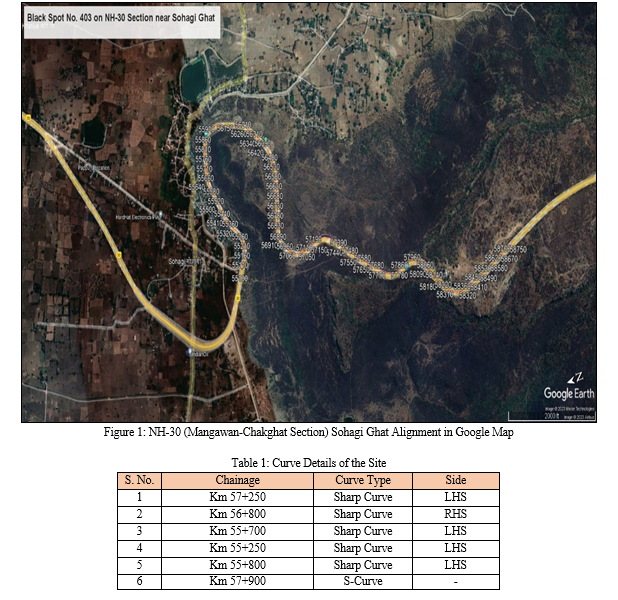
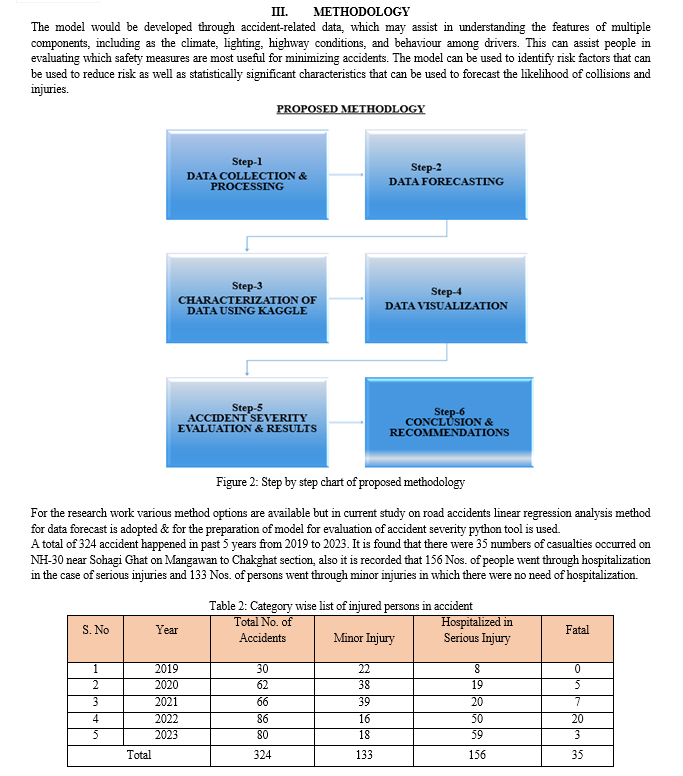
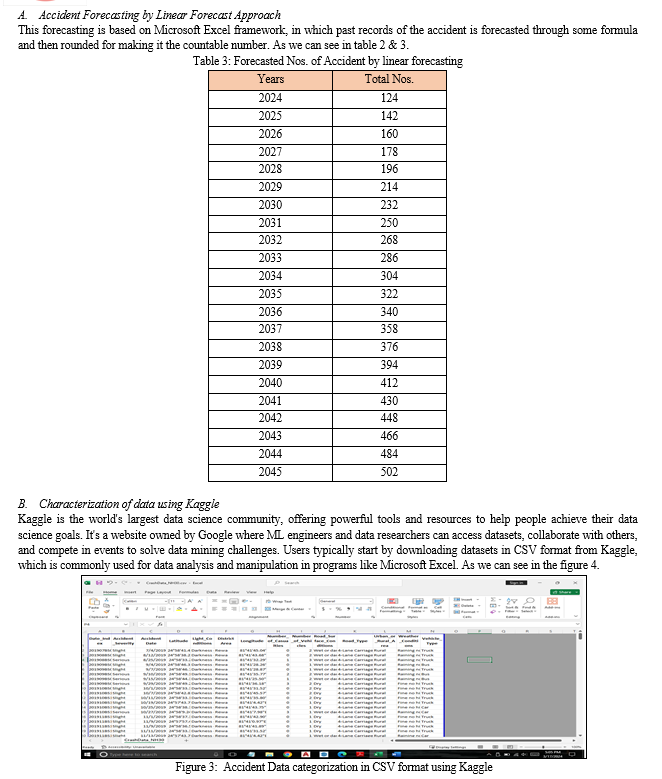
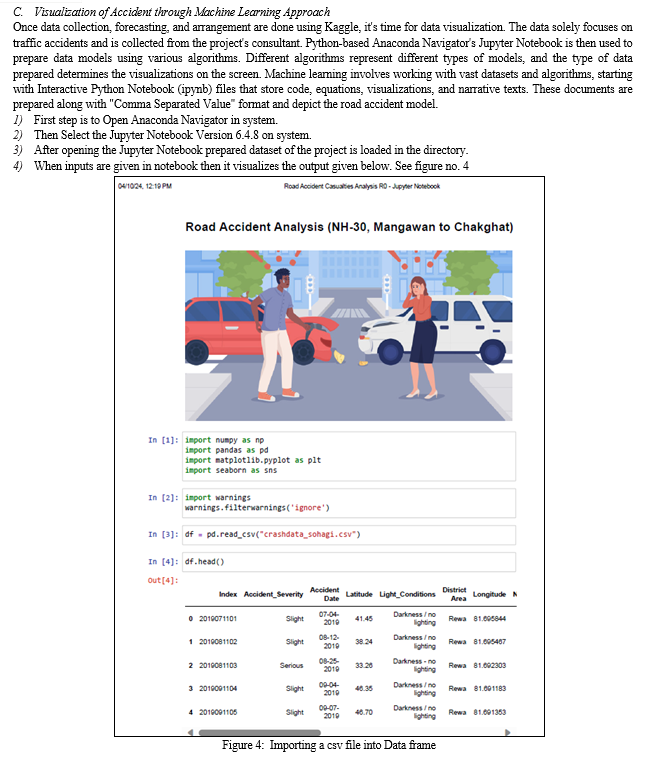
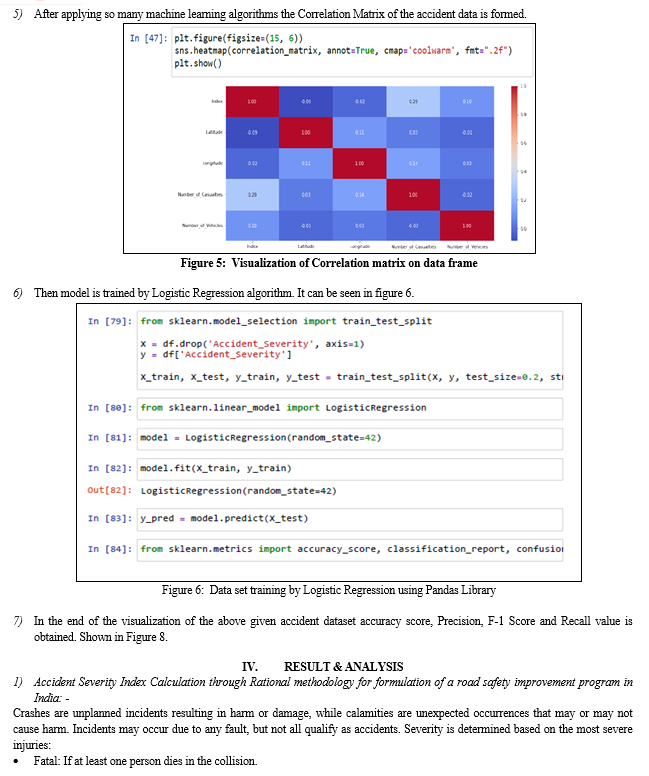


V. RECOMMENDATIONS FOR THE FUTURE WORK
- To improve future outcomes and reduce fatalities, a safety program involving the Gram Panchayat and local administration should be organized to raise road safety awareness. Public consultations should include local residents. Additionally, schools and Anganwadi centers should educate children about road safety.
- Research shows that various models visualize road accident crash severity. The logistic regression model relates predictor variables to binary outcomes, while the Random Forest (RF) model uses averages or votes for aggregated probabilities. Naïve Bayes (NB) predicts based on class probabilities, K-Nearest Neighbors (KNN) uses the majority class of nearest neighbors, and Neural Networks (NNN) mimic the brain's structure with layers of interconnected neurons and use SOFTMAX for classification. Probabilistic models yield varying results, whereas deterministic models like SVM, Linear Regression, Decision Trees, GBM, Rule-Based Models, and LDA do not rely on probability calculations. Deterministic models should be trained for better incident visualization based on data set accuracy. Further study of this research needs to be implemented through different machine learning model techniques.
- In this thesis, we incorporate numerous road user parameters, but including additional characteristics such as age, sex, experience, behavior, and health data would enhance model visualization. Similarly, expanding datasets to include road characteristics like maintenance, conditions, and speed limits, along with ecological factors, would improve model training and visualization.
- To reduce road accident injuries, this research recommends trimming the ghat section to a minimum width of 7.0m towards the hillside, per IRC-73:2018 standards. This includes a 3.5m lane, 1.20m for an RCC drain, and 2.30m for a utility corridor during the execution of the site in reconstruction.
a. Hill Trimming: Trimming the hillside will increase Stopping Sight Distance (SSD) and Intermediate Sight Distance (ISD), reducing accident frequency.
b. Road Furniture & Safety Signage: Install traffic signage, Chevron signs, gantries, cautionary signs, rumble strips, road markings, raised pavement markers, delineators, anti-glare sheets, and solar high mast lighting on steep curves for improved visibility.
c. Passing Places: Provide passing places on the project section as per IRC-SP:48-1998 and IRC:52-2019 for vehicle breakdowns and to facilitate smoother traffic flow, marked with dashed lines for safe overtaking.
Conclusion
Starting from process-by-process data collection to result evaluation several steps are involved in road accident prediction model; We used machine learning framework. In machine learning, we have a plenty of techniques of machine learning for better data visualization of road accident and road accident severity. In general, we graphically visualize the data sets by the using so many algorithms. It will be essential to develop the ability to identify situations in which serious injuries are most likely to happen in order to establish techniques that will enhance road user safety. Based on data gathered between 2019 and 2023, this analysis revealed specific factors that have a major influence on the level of severity of accidents/ fatalities caused by vehicular accidents in Sohagi Ghat on NH-30. The most important factors were the types of vehicles, the weight of the vehicle, Geometrics of the accident spot, accident\'s geographic coordinates, weathering conditions, and the permissible speed. We applied the simplest form of machine learning. Some of the conclusions are given as follows: -. Logistic Regression, As an outcome of this research work in terms of accident severity percentage which is further classified in three categories, for fatal category the percentage of severity of accident is 10.8%, for the serious/ grievous injured category the percentage of severity of accident is 48.2% and for the normal injury which do not required to be hospitalized has the percentage of 41.0%, while in the other way if we calculate the road accident severity index then our result will be 0.21. When it came to predicting the severity of injuries occurred accidents at Sohagi Ghat on NH-30, the Logistic Regression showed the accuracy with 0.85, which is quite effective to highlight the accidents. Accident Forecasting for the upcoming 20 years is studied using Linear Forecasting approach. In which accident trend is rising year by year. While comparing the forecast rate of accidents for year 2045 to base year 2019 the accident rate is rises to 11.16 times.
References
[1] Amir Elalouf et al (2023). “Developing machine-learning-based models to diminish the severity of injuries sustained by pedestrians in road traffic incidents.”, https://doi.org/10.1016/j.heliyon.2023.e21371 [2] Aamir Ali Khan et al. (2023, February). “Road Accident Analysis and Safety Audit: A Case Study of MDR-132”, https://doi.org/10.26552/com.C.2023.026 [3] Antoine Gatera et al. (2023, May). “Comparison of random forest and support vector machine regression models for forecasting road accidents”, https://doi.org/10.1016/j.sciaf.2023.e01739 [4] Balasubramani S. et al. (2023, December). “DDDS: Driver decision support system based on the driver behaviour prediction to avoid accidents in intelligent transport system”, https://doi.org/10.1016/j.ijcce.2023.12.001 [5] Highway engineering by S.K. Khanna, C.E.G. Justo & A. Veeraragavan. (10th revised Edition) (2017, January) [6] https://en.wikipedia.org/wiki/Machine_learning [7] https://www.kaggle.com/datasets/nezukokamaado/road-accident-casualties-dataset [8] https://towardsdatascience.com/regularization-in-machine-learning-76441ddcf99a [9] https://intellipaat.com/community/368/how-to-interpret-loss-and-accuracy-for-a-machine-learning-model [10] IRC 37 - 2018 for Design of Flexible Pavements (Fourth Revision) (without the CD) [11] IRC 58 – 2015 Guidelines for the Design of Plain Jointed Rigid Pavements for Highways (Fourth Revision) (without CD). Published by: Indian Road Congress. [12] IRC: SP:48-1998 Hill Road Manual, Published by: Indian Road Congress. [13] IRC: SP:84-2019. Manual of Specifications and Standards for Four Laning of Highways (Second Revision). Published by: Indian Road Congress. [14] IRC:35-2015 - Code of Practice for Road Markings. (Second Revision). Published by: Indian Road Congress. [15] IRC:52-2019 Guidelines for the Alignment Survey and Geometric Design of Hill Roads (Third Revision) Indian Roads Congress 2019. Published by: Indian Road Congress [16] IRC:67-2022- Code of Practice for Road Signs (Third Revision). Published by: Indian Road Congress [17] Izuchukwu Chukwuma Obasi et al. (2023, July). “Evaluating the effectiveness of machine learning techniques in forecasting the severity of traffic accidents.”, https://doi.org/10.1016/j.heliyon.2023.e18812 [18] Md Adilur Rahim (2021, May), “A deep learning-based traffic crash severity prediction framework”, https://doi.org/10.1016/j.aap.2021.106090 [19] Mireille Megnidio- Tchoukouegno et al. (2023, January), “Machine Learning for Road Traffic Accident Improvement and Environmental Resource Management in the Transportation Sector”, https://doi.org/10.3390/su15032014 [20] Nicola Tamascelli et al. (2022, June), “Learning from major accidents: A machine learning approach”, https://doi.org/10.1016/j.compchemeng.2022.107786 [21] Official Website of Public Works Department, Uttar Pradesh, Available from https://uppwd.gov.in/site/writereaddata/siteContent/20190424201227766620.pdf [22] Praveen Maghelal et al. (2023, October). “Severity of vehicle-to-vehicle accidents in the UAE: An exploratory analysis using machine learning algorithms” https://doi.org/10.1016/j.heliyon.2023.e20694 [23] Pedestrian Safety, A road safety manual for decision-makers and practitioners, in: Pedestrian Safety: a Road Safety Manual for Decision-Makers and Practitioners, second ed., World Health Organization, Geneva, 2023. https://apps.who.int/iris/bitstream/handle/10665/367419/9789240072497-eng.pdf? sequence=1 [24] Philippe Barbosa Silva et al. (2020, October). “Machine learning applied to road safety modeling.”, https://doi.org/10.1016/j.jtte.2020.07.004 [25] Piotr Gorzelanczyk (2023, March). “Using neural networks to forecast the number of road accidents in Poland taking into account weather conditions.” https://doi.org/10.1016/j.rineng.2023.100981 [26] Rakesh Mehar et al. (2013), “A Systematic Approach for Formulation of a Road Safety Improvement Program in India”, doi: 10.1016/j.sbspro.2013.11.199 [27] Shuli Wang et al. (2024, March). “Geographically weighted machine learning for modeling spatial heterogeneity in traffic crash frequency and determinants in US.” https://doi.org/10.1016/j.aap.2024.107528 [28] Shubham Pandey et al/ (2022, May). “Identification and Prioritization of Black Spots in Hilly Road Segment Using Accident Severity Index Method”, (http://creativecommons.org/licenses/by/4.0/) [29] Slava Birfir et al. (2023, April). “Building machine learning models for reducing the severity of bicyclist road traffic injuries” https://doi.org/10.1016/j.treng.2023.100179 [30] Specifications for roads and bridges by MORTH (Ministry of Road Transport and Highways) - includes details of road construction and maintenance. All highways’ projects in India are following MORTH Specifications for construction work. https://archive.org/details/gov.in.mort.250.2013 [31] Stefan Candefjord et al. (2021, September), “On Scene Injury Severity Prediction (OSISP) machine learning algorithms for motor vehicle crash occupants in US”, https://doi.org/10.1016/j.jth.2021.101124 [32] Suleyman Ceven et al. (2024, March). “Traffic accident severity prediction with ensemble learning methods.” https://doi.org/10.1016/j.compeleceng.2024.109101 [33] The United Arab Emirates Government Portal Information and Services: Road Safety, United Arab Emirates, Abu Dhabi, 2022. [34] Venkataraman Shankar et al. (1995, June), “Effect of Roadway Geometrics and Environmental Factors on Rural Freeway Accident Frequencies”. https://doi.org/10.1016/0001-4575(94)00078-Z [35] World Health Organization, Road Traffic Injuries, Fact Sheet, 2018. http://www.who.int/en/news-room/fact-sheets/detail/roadtraffic-injuries. (Accessed 20 March 2022). [36] World Health Organization, World health statistics. http://apps.who.int/iris/bitstream/handle/10665/272596/9789241565585-eng.pdf?ua=1, 2018. (Accessed 20 March 2022). [37] World Health Organization, Global Status Report on Road Safety, 2018. https://www.who.int/violence_injury_prevention/road_safety_status/2018/en/.(Accessed 20 March 2022), 2018c. [38] World Health Organization, Road traffic injuries. http://www.who.int/news-room/fact-sheets/detail/road-traffic-injuries, 2018. (Accessed 17 January 2022). [39] World Health Organization, The Department of Social Determinants of Health, Safety and Mobility Unit, https://www.who.int/teams/social-determinants-of-health/safety-and-mobility/global-status-report-on-road-safety-2023 [40] Xian Wen et al. (2021, July), “Applications of machine learning methods in traffic crash severity modelling: current status and future directions”, https://doi.org/10.1080/01441647.2021.1954108
Copyright
Copyright © 2024 Alkesh Kumar Khade, Dr. Rakesh Mehar. This is an open access article distributed under the Creative Commons Attribution License, which permits unrestricted use, distribution, and reproduction in any medium, provided the original work is properly cited.

Download Paper
Paper Id : IJRASET62539
Publish Date : 2024-05-23
ISSN : 2321-9653
Publisher Name : IJRASET
DOI Link : Click Here
 Submit Paper Online
Submit Paper Online

